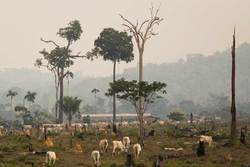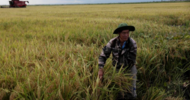Oakland Institute | 1 September 2022
Brazil: Time to end the ravages of industrial agriculture in the Cerrado and the Amazon
With recent media coverage linking the war in Ukraine to increased threats to “the world’s ability to feed itself,” much concern has been expressed about its impact on Brazil — one of the world’s largest agricultural producers.
Brazil is the world’s leading soybean producer and exporter, accounting for 50 percent of global trade of the commodity, with the EU and China as the two major importers. It also ranks among the top three global exporters of corn, sugar, beef, chicken, and pork meat. Agricultural production is highly mechanized and reliant on the extensive use of chemical inputs and synthetic fertilizers, which explains why high oil prices and the disruption of the global fertilizer trade resulting from the war in Ukraine could undermine Brazil’s ability to supply the world with agricultural commodities.
But are these concerns valid given the true impact of the Brazilian agricultural model?
The high environmental and human costs of Brazil’s agricultural boom
Over the past two decades, the expansion of cattle ranching and industrial agriculture in Brazil, especially soybean monocultures, has been devastating for the planet, the climate, and the people. Between 1985 and 2020, the Brazilian Amazon lost around 82 million hectares of natural vegetation, including 53 million hectares of forests. Coincidentally, during this time, agricultural land rose to more than 81 million hectares within the country. In 2020 alone, Brazil lost 2,4 million hectares of savanna, of which 40 percent were in protected areas.
Rich biodiversity ecosystems are being destroyed at a rapid pace to be turned into pastures for an ever-expanding cattle herd or transformed into large crop fields to feed farmed animals. With some 200 million heads of cattle raised, about 45 million hectares of forest have been converted to cattle pasture since the late 1990s. Unsurprisingly, Brazil is one of the largest emitters of GHGs on a per capita basis, with deforestation as a significant contributor, which has resulted in some 34.5 Gt of CO₂ emissions over the past 20 years.
The Cerrado biome — a wooded grassland stretching over 200 million hectares (more than Germany, France, England, Italy, and Spain combined) — has already lost nearly half of its native vegetation to pastures and monocrops. In January 2022, scientists sounded the alarm that monocultures in the Cerrado were a major threat to climate, water supply, and food security. Friends of the Earth and Brazilian’s Rede Social de Justiça e Direitos Humanos (Rede Social) echoed these concerns in April, documenting in a report the devastation caused by chemical-intensive monoculture production of soy and corn in the region. This disaster affects us all because the Cerrado biome has been considered not only “Brazil’s water tank,” but the world’s most biodiverse savanna and a vital carbon stock.
The massive use of pesticides has also had a disastrous impact on Brazilian communities — with widespread contamination of soil, water, and livestock — threatening their health and livelihoods.3 It has resulted in the disappearance of traditional crops including beans, rice, and pumpkins, among others. Numerous negative public health impacts, including the poisoning of residents tied to toxic pesticide use, and the consumption and pollution of natural resources, have been widely documented.
Furthermore, the expansion of industrial agriculture involves land grabs and widespread human rights abuses. Killings, violence, and persecutions are constant for those defending land and environmental rights, including Indigenous and Afro-descendant communities. In many cases, police or members of the security forces are implicated in the killings. Amazon Watch has recorded a 150 percent rise in illegal land invasions since far-right President Jair Bolsonaro took power in 2019 with his pro-business, anti-Indigenous rhetoric. His government has slashed the budget, staffing, and enforcement of the agencies responsible for the protection of Indigenous rights (FUNAI), land reform (INCRA), and environmental protection (IBAMA). It was in this context that in 2019, ranchers set large portions of the Amazon on fire, threatening a multitude of Indigenous communities and the ecosystems on which they rely. In August 2021, a coalition of Indigenous groups accused Jair Bolsonaro’s government of genocide, crimes against humanity, and ecocide before the International Criminal Court (ICC).
This is not about feeding the world
Let’s be clear. Contrary to what we are told over and over again, this human and environmental destruction is not happening — and neither is it needed — to feed the world. About three-quarters of all soy production goes into animal feed for the meat industry, both in Brazil and in foreign markets, with the remainder being used for agrofuel and food. The expansion of soy monocultures is driven by corporations seeking to produce cheap meat products for mass consumption.
Furthermore, millions of hectares in Brazil are being irreversibly affected by the expansion of agrofuel crops — destroying the livelihoods of rural communities and eroding biodiversity. Brazil is the largest ethanol producer globally and has put in place a series of policies and mechanisms to support the expansion of agrofuels. Brazil’s ethanol is produced almost exclusively from sugarcane, cultivation of which has significantly expanded in recent years — reaching 14 percent of the country’s total cropland (65.4 million hectares).
Even if most of the country’s ethanol is used domestically, Brazil exports significant quantities (1.95 million cubic meters in 2021), with South Korea and the United States being main destinations.
Who benefits?
This expansion of industrial farming does not benefit the majority of Brazilians either. Beyond the direct impact on Indigenous and farming communities, land is increasingly concentrated in the hands of a relatively small number of industrial farms. 90 percent of soy production is controlled by large agribusinesses. The growing inequality in access to land is massive in Brazil: while 2.8 percent of landowners own over 56 percent of all arable land, 50 percent of smallholder farms, which employ about two-thirds of the rural population, have access to only 2.5 percent of the land. The collusion between the government and the large agribusiness sector is blatant, as was demonstrated by the appointment of Tereza Corrêa da Costa Dias as the head of the Ministry of Agriculture in January 2019. Mrs. da Costa Dias belongs to one of the most powerful agribusiness families in the country and has a long history of pushing for the privatization of public lands and violence against Indigenous communities.
Brazilian interests then trade with foreign firms to reach export markets. For instance, a 2022 investigation by Earthsight and Brazilian De Olho nos Ruralistas uncovered how soy grown on land stolen from the Indigenous Guarani Kaiowá is sold to American agribusiness giants Cargill and Bunge, key suppliers of the commodity on international markets. The research also revealed how chicken exported from Brazil is fed soy coming from the same land. It is then sold by some of the UK’s largest retailers, including KFC, Sainsbury’s, Asda, Aldi and Iceland, as well as pet food sold by German supermarkets, including Rewe Markt, Netto Marken-Discount, Lidl, Aldi and Edeka.
With the worsening climate and food crisis, it is urgent to change the way we produce and trade food. The livestock sector is responsible for 14.5 percent of anthropogenic greenhouse gas (CHG) emissions globally and is by far the largest driver of deforestation in South America. According to the Lancet, if nothing changes, the sector alone could account for 49 percent of emissions by 2030. The August 2019 Intergovernmental Panel on Climate Change (IPCC) called for the abandonment of monocrops as a measure to mitigate the climate crisis. Large-scale meat and feed production that keeps expanding in Brazil should therefore be a major concern for the world, as it is a major driver of climate change, degradation of natural resources, biodiversity loss, and pollution.
How to end the devastation?
Given Bolsonaro’s disregard for Indigenous people, the environment, and the climate crisis, the presidential elections of October 2022 could be a decisive turning point for Brazil. Its citizens could choose to significantly reduce agriculture’s impact on climate and food security if it shifts production away from industrial animal agriculture and energy-intensive monoculture for feed and agrofuels to more ecological, plant-based, and diversified practices. Reversing Bolsonaro’s policies that have undermined the country's natural resources and endangered Indigenous communities is critical. Respecting and promoting the traditional knowledge and sustainable lifestyles of Indigenous people is also paramount to mitigating food insecurity and climate change and protecting forests and biodiversity.
The problem, however, does not just lie with the current government of Brazil. Despite their commitments to “a transition [to] food systems compatible with climate and biodiversity imperatives,” development banks continue to support destructive agricultural practices. In June 2022, the International Finance Corporation (IFC) approved a loan of US$200M to Louis Dreyfus for the purchase of soy and corn produced in the heavily threatened Cerrado biome. Trade partners also bear heavy responsibility, as European countries, China, and the US seem unwilling to restrict imports from Brazil despite the massive human rights violations and environmental devastation.
It is often argued that it is the growing global demand for meat that is driving deforestation. However, what is happening in Brazil demonstrates that it is the availability of meat and feed products made cheap by externalizing the social and environmental costs of production that is driving this increased demand. It is urgent for policy makers to recognize and address these externalities, which corporations and industries inflict over the Indigenous Peoples and the rest of the world, with their dramatic social and environmental costs. As the climate emergency gets more acute and devastating everyday, we can’t waste more time waiting for the decisive actions required to end the ravages caused by industrial agriculture in Brazil.












